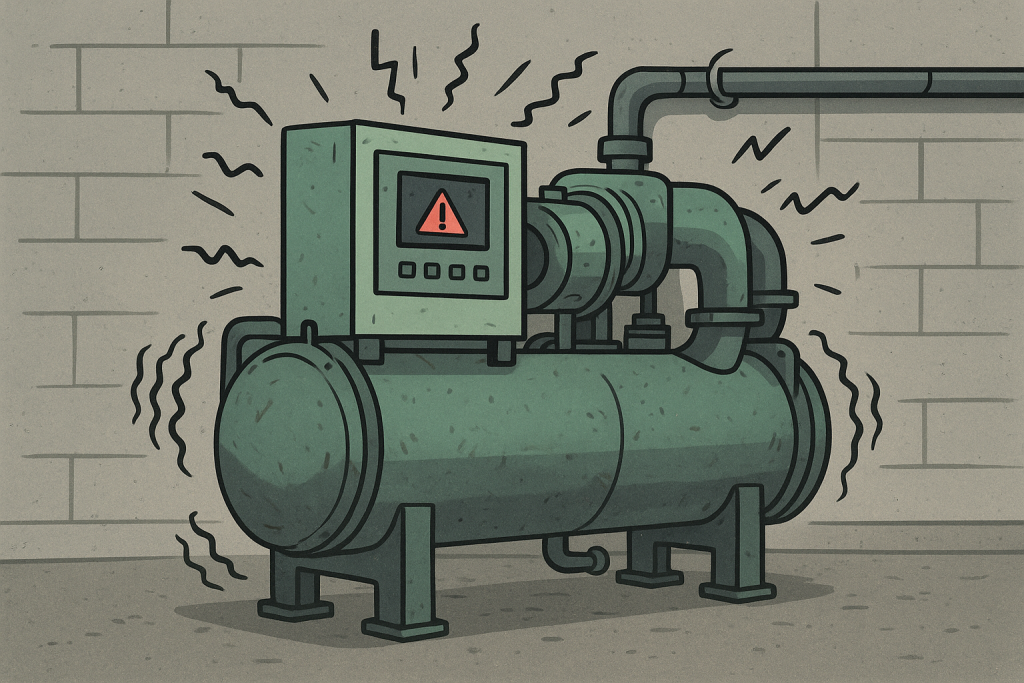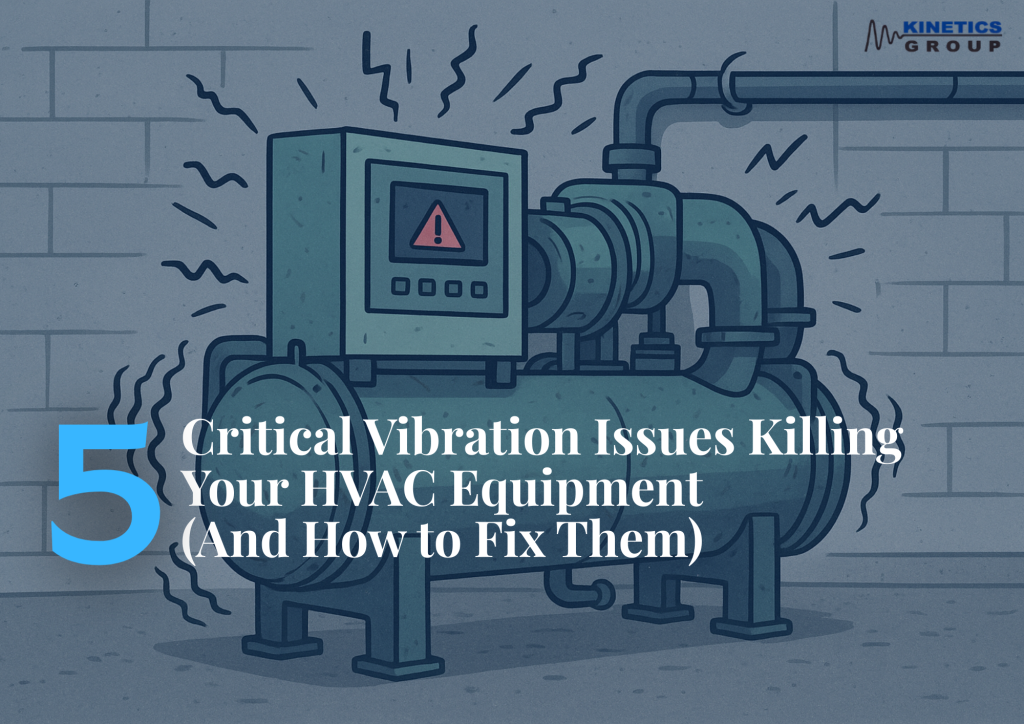In the intricate world of building management and industrial operations, HVAC (Heating, Ventilation, and Air Conditioning) systems are silently working to maintain optimal indoor environments. However, there’s a hidden enemy that can silently sabotage their efficiency, shorten their lifespan, and disrupt the peace: VIBRATION.
Uncontrolled vibration in HVAC equipment isn’t just an annoyance; it’s a critical issue that can lead to costly breakdowns, increased energy consumption, and uncomfortable noise levels (ASHRAE Handbook – HVAC Applications, 2023). At Kinetics Group, we understand these challenges intimately. With decades of expertise in noise and vibration control, we’re here to shed light on the most common vibration culprits and, more importantly, provide actionable solutions.

Critical Vibration Issue 1: Unbalanced Components
One of the most frequent causes of excessive HVAC vibration stems from unbalanced rotating components. Fans, motors, and blowers, which are integral to air movement within HVAC systems, can become unbalanced over time due to dirt buildup, uneven wear, or slight manufacturing imperfections (ISO 10816-3, 2009).
An unbalanced rotor generates centrifugal forces that manifest as destructive vibrations, accelerating bearing wear, overheating motor windings, and increasing operational noise (Bies & Hansen, 2017).
Solution: Regular cleaning of fan blades, dynamic balancing by trained technicians, and the use of Spring or Rubber Mount Isolators to absorb residual vibration energy (ASHRAE Handbook – HVAC Systems and Equipment, 2020).

Critical Vibration Issue 2: Loose or Worn Mounting Hardware
The foundation upon which HVAC equipment rests is just as crucial as the equipment itself. Over time, bolts, nuts, and mounting brackets can loosen due to constant operation, thermal expansion/contraction, or improper installation (ASHRAE Handbook – HVAC Applications, 2023).
When mounting hardware is compromised, vibrations are directly transmitted to the building structure, resulting in rattling, structural fatigue, and noise complaints.
Solution: Implement a preventive maintenance program with regular torque checks and replacement of worn vibration mounts with Spring Isolators or Neoprene Pads (McGraw-Hill HVAC Engineer’s Handbook, 2013).

Critical Vibration Issue 3: Misaligned Components
Misalignment between coupled components — typically between a motor and the driven equipment — is a major source of vibration (ASHRAE Research Project RP-755, 1997). Causes include imprecise installation, thermal growth, or building settlement.
Misaligned shafts create excessive bearing loads, seal wear, and wasted energy.
Solution: Use precision laser alignment tools during installation and re-check alignment periodically. Incorporate Flexible Connectors to accommodate minor residual misalignments (ASHRAE Handbook – Fundamentals, 2021).

Critical Vibration Issue 4: Refrigerant Line Vibration
Refrigerant line pulsations from compressors can cause excessive vibration if not properly supported (ASHRAE Handbook – HVAC Systems and Equipment, 2020).
Without proper restraint, vibration can lead to fatigue cracks and refrigerant leaks — costly and environmentally damaging.
Solution: Secure refrigerant lines with proper supports at recommended intervals, avoiding rigid contact with structure. Install Pipe Riser Anchors and Guides to dampen pulsations (Bies & Hansen, 2017).

Critical Vibration Issue 5: Ductwork Vibration and Resonance
Improper duct sizing, high air velocities, or turbulent flow can excite duct panel vibrations. When the airflow-induced frequency matches the duct’s natural frequency, resonance amplifies the vibration (SMACNA HVAC Systems Duct Design, 2006).
Solution: Design duct systems per ASHRAE guidelines to minimize turbulence and excessive velocities. Apply Duct Silencers or Acoustic Louvers to absorb noise, and use Acoustic Barriers on duct exteriors to prevent resonance (ASHRAE Handbook – Fundamentals, 2021).

The Kinetics Group Advantage
At Kinetics Group, we go beyond problem identification. We engineer tailored vibration control solutions in compliance with ASHRAE, SMACNA, and ISO standards. From Spring Isolators to Inertia Bases, Acoustic Louvers, and Silencers, our products are backed by decades of research and field experience.
References
- ASHRAE Handbook – HVAC Applications, 2023, Chapter 48: Noise and Vibration Control.
- ASHRAE Handbook – HVAC Systems and Equipment, 2020, Chapter 20: Air-Handling and Distribution.
- ASHRAE Handbook – Fundamentals, 2021, Chapter 21: Duct Design.
- SMACNA HVAC Systems Duct Design Manual, 2006 Edition.
- ISO 10816-3:2009, Mechanical Vibration – Evaluation of Machine Vibration.
- Bies, D.A. & Hansen, C.H., Engineering Noise Control: Theory and Practice, CRC Press, 2017.
- McGraw-Hill HVAC Engineer’s Handbook, 2013 Edition.
- ASHRAE Research Project RP-755, Fan Vibration and Noise Reduction, 1997.



